How to level a pinball machine
After setting up a pinball machine at a new location, you should take time to adjust the level and angle of the playfield. Each pinball machine leg has a leveler at the bottom, which you can rotate to extend the leg. This way you adjust the height of each leg and increase or decrease the angle of the playfield and make it horizontal level.
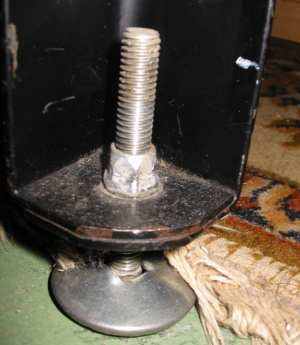
Leg levelers underneath each pinball machine leg. With these you can adjust the height.
By rotating the leveller clockwise it'll extend out of the leg. On older games it can be rusted, you may need to spray some light oil in it.
With new legs I usually spray the leveller screws with some silicone spray, to protect them.
Sometimes a nut is installed. This is to set the levellers at a certain height and to prevent them for changing.
Why to set up a pinball machine
Adjusting the angle and leveling the playfield is important for gameplay. Certain shots will be more difficult or easy to make, you can make the game faster (and more fun to play). You can also influence the path of a pinball when they ie fail to get up a ramp and roll back, thus minimizing drains and frustration. How much influence it all has depends a bit on the playfield layout and what shots you have to make, but a very incorrect leveled game can be really frustrating to play and no fun at all - while a 'tuned' game set at the correct game can be a lot of fun to play.
Many people don't know how to properly adjust the level - or they know but they don't bother to check it.
You even don't need a level to notice a game is misaligned. When you want to put a raised playfield (after a repair
at the bottom of it) back into the cabinet and you notice the hooks at the front of the cabinet don't align perfect,
this usually is an indication the cabinet is not leveled properly. Especially if you have to put pressure on the playfield
to fit it, in most cases this is because one of the legs is set too high and this causes the whole cabinet to be twisted.
You have to correct this situation as it will put stres on the corners of the cabinet and also twist the playfield.
Don't just set up a game at a very cheap angle and think it'll make you a better player. Yes, the game will play faster,
but you'll totally change the feel of the game. On a very steep game, you'll get mostly get vertical ball movements.
On a game that's set too flat, you'll get more (even too much) horizontal ball movements. For instance when the ball bounces
on a rubber post (or the top of a slingshot) it'll bounce around or feel like floating from left to right.
A steeper
game will not get this, but every shot will go to the back (which may be good if it's a fan layout), but that'll make
certain shots on the side more difficult to make. Therefor it's best to start with the 6.5 to 7 degrees angle for which
the game is designed.
How to adjust the level
There are three things to adjust:
- Back of the playfield (back legs) need to be horizontal
- Front of the cabinet (front legs) need to be horizontal
- The slope of the playfield (difference between front and back legs)
No matter what, the first two should always be horizontal. If you have moved a game or have made any adjustment to the slope of the playfield, always check these again (many people quickly turn the back legs to change the playfields slope and forget to check if the back is level). As a general rule of thumb you should have a slope of about 6.5 to 7 degrees playfield angle.
A 6.5 degree incline of the playfield however is not a fixed rule. It's best to initially set it to this slope as electronic pinball
machines are designed to play with this slope. Older electro-mechanical pinball machines only need about 5 degrees, but
when totally revising a game it may be more fun at a steeper angle.It's a matter of personal preference,
some people prefer a game that plays much faster, but as said above, it'll feel different..
After a few days or weeks of playing you can experiment with a steeper angle
and see if you like more how the game plays now.
When you don't like how a pinball comes down from a ramp, you can
quickly test this. Remove the playfield glass and let a pinball roll down, see where it ends. Do a significant change to the angle
(I use pieces of wood that I put under the legs to quickly test different setups) and see how the path is adjusted.
This way on some games you can decide if a pinball will bounce against a slingshot or will pass it so you can catch it on a flipper.
Also if you feel you can't make certain shots, you hit many posts, adjusting the angle of the playfied can help (together with adjusting
the flipper bats).
Serious players should also experiment with the angle of the playfields on their own pinball machines.
If you play a lot of games on a specific machine, you'll get used to the timing certain shots need. Especially if you have like
an upper flipper, or a loop shot that quickly returns the pinball back to the flippers so you can quickly make another shot.
Play enough games and you'll get used to the timing and can hit that particular shot with your eyes closed.
When you play the same model at another location, you usually play worse as your timing is a bit off (this can be as small
as a few milliseconds). Each pinball machine is different, its flipper mechanisms can have more plays (wear), weaker or stronger
flippers, and the playfield slope can be different. By drastically changing the slope of your own games, you can train yourself
to adjust the way you play to different conditions.
Anyway, what are the steps required to level a game correctly ?
In the past I started with the front legs, and then did the back. Since then I have switched this routine and start with the back legs.
You can choose how you do it, but it'll probably depend if you have other games or not.
If you don't have any other pinball machines, if you're a very tall or short person, then start with the front legs.
Adjust the height so you feel comfortable reaching the flipper buttons. If they're too high or low it won't play natural.
Tall people may find that the front of a game is then too low and prefer to increase the height a bit. Just experiment
so you find a position that suits you. Many people that have many pinball machines adjust the front of the games to have
the same heigt. This way the position of the flipper buttons (and the way you stand at each game) is always the same.
Once the front is set up, then adjust the back legs (if the levellers can be extended enough) to get the correct playfield angle.
If you have multiple games (of the same brand), you probably want to start with the back legs. Set up the legs so they are similar to the other
machines. It may be my OCD, but nothing is nicer than a row of pinball machines where the backboxes all align on the top.
If each machine is half an inch lower or higher, your row of pinball machines will look off.
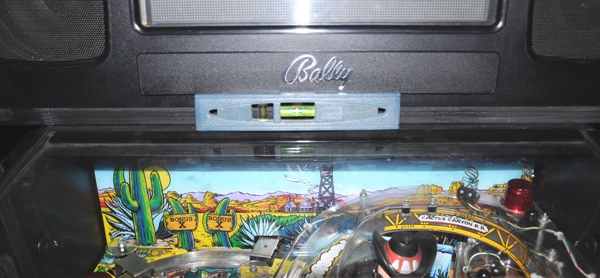
So start with the back legs. Extend the levellers 3/4th out of the legs, try to have both legs equal as much as you can.
Put an inclinometer either on top of the backbox, or at the top of the playfield glass (just at the backbox).
See how far you're off and adjust. I use an electronic level, this makes a sound when I reach 0 degrees. That way I don't have
to crawl from under the playfield each time to verify. Having someone else to watch the level can also make your life easier :)
Then you start on the front legs.
Adjust the front legs to adjust the slope of the playfield. As said above, it's best to initially set a game to 6.5 or 7 degrees, and play the game and see if you like it that way. It is not advised to lower the incline beneath 6 degrees, as this will make the game play too slow and make it too easy and boring..
Now comes the most difficult part for many people - how to find and measure the correct inclination of the playfield ?
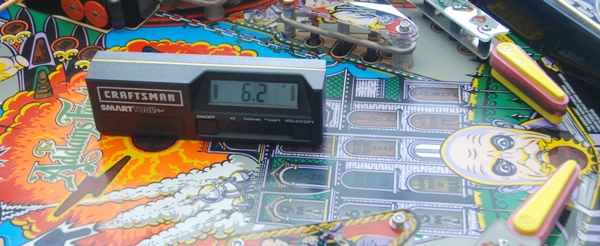
If you have an electronic inclinometer, it's easy.. but we don't all have one of these toys. If you have an Iphone, there's an application available to use the phones built-in inclinometer. I'm not sure how accurate it is, but it'll certainly be good enough to give you a general idea (ie if you're at 4, 6 or 8 degrees).

A lot of pinball machines have a small bubble level at the right side. This can be used, but you have to know its limitations: it's not very accurate. It's a cheap help but depending on its construction and even on how tight it's screwed into the wood if can give false results. Anyway, if it's the only thing you have: On Bally/Williams pinball machines, the first (bottom) line is 6 degrees, each following line is half a degree. The playfield is at 6.5 degrees when the top of the bubble just reaches the second line from the bottom. On some bubble levels it's indicated with a thicker line.
Now for those of us that don't own expensive iphones or inclinometers, wouldn't it be easier if you could check the optimal angle
of the playfield using a regular bubble level ?
That's why I have made this free playfield leveling tool.
Just print it, glue it to some thick cardboard (it has to be strong enough so you can put your level onto it) and cut it out. The triangle has an angle of 6.5 degrees. Put it in the middle of the playfield, put your bubble level on it, and adjust the back legs of the machine. When the bubble level indicates it's horizontal, your playfield has an angle of 6.5 degrees.
After adjusting the angle of the playfield, double check the back legs are horizontal.
I usually put the bubble level at the very back of the playfield like you can see in the picture.
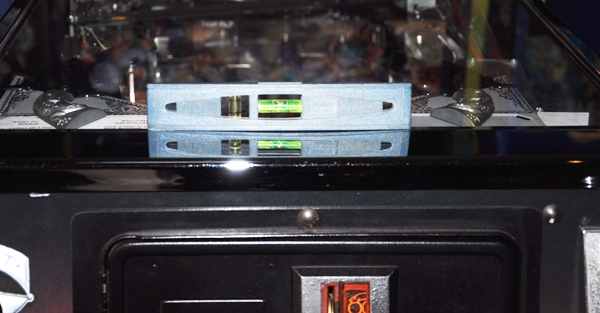
Note the level sits on the lockdown bar. Even better would be to remove the lockdown bar and measure the wood of the cabinet, or to put it on the playfield glass.
A lockdown bar isn't always completely horizontal when mounted to the cabinet.
Even better is to level the playfield itself,
but then you have to make sure you keep your tool totally parallel to the front of the cabinet which is not always easy to do.
Usually I put the level on the wood and double check the playfield hangs straight in the cabinet on its hooks.
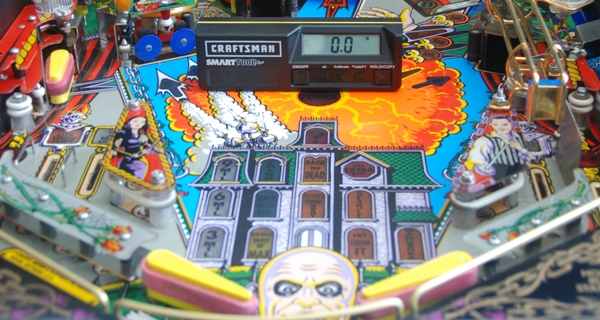
An electronic inclinometer can also be used. When measuring on the playfield, because of its slope you have to make sure
it's parallel to the front of the cabinet. It would've been better to set it on one of the horizontal line in the Mansion.
A final test (you never know your bubble level isn't perfect): remove the playfield glass, take a pinball and let it roll from somewhere in the middle of the playfield. It should roll straight down, between the flippers.
Are we really finished now ? Not really. If you really want to level your pinball machine and do everything right, you have to check the tilt plumb in the cabinet. When you have adjusted the inclination a lot, it's possible the tilt has become too sensitive.
I hope you now have an idea what you can do to set up and level your pinball machine. Do you have to strictly follow this procedure ? That's your decision, I have to admit I don't follow it myself for every of my pinball machines. What is important that you take time to level your pinball machine. Don't just attach legs to the cabinet and never adjust anything..
